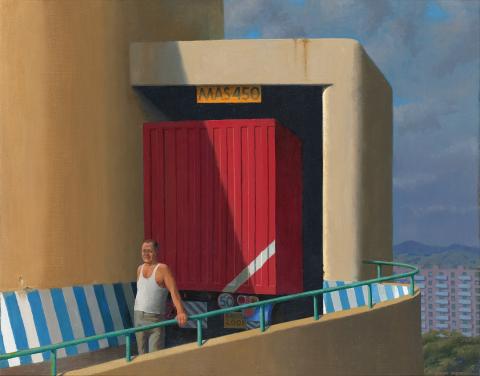TRUCK AND DRIVER, 2000 – 2001
JEFFREY SMART
oil on canvas
80.0 x 100.0 cm
signed lower right: JEFFREY SMART
Philip Bacon Galleries, Brisbane (label attached verso)
Private collection, Queensland, acquired from the above in 2001
Jeffrey Smart, Philip Bacon Galleries, Brisbane, 4 September – 6 October 2001, cat. 11 (illus. in exhibition catalogue, p.15)
The Landscape 1804 – 2015, Philip Bacon Galleries, Brisbane, 2 – 27 February 2016, cat. 40 (illus. in exhibition catalogue, p.30)
First Study for Truck and Driver, 2000, oil on board, 37 x 39 cm
Second Study for Truck and Driver, 2000, oil on canvas, 45.5 x 55 cm
both exhibited Jeffrey Smart Recent Paintings, Philip Bacon Galleries, Brisbane, 4 September – 6 October 2001, cat. no. 12 and 13 respectively
Truck and Driver, 2000 – 2001 is a classic Jeffrey Smart painting which includes all the motifs of his art, from road signs to regimented buildings. Motionless in a poetic moment of time, the painting is endowed with such motifs celebrated in earlier works as the sweeping curve of The Cahill Expressway, 1962 (collection of the National Gallery of Victoria, Melbourne); the lined back of the truck of Truck and Trailer Approaching a City, 1973 (Art Gallery of New South Wales, Sydney); and variations on the theme of road signs as celebrated in the two versions of Autobahn in the Black Forest, 1979 – 80 (private collections). And, of course, there are the ubiquitous apartments. Even the deadpan title has that characteristic Smart touch of anonymity. Amidst such paradoxes, the rush of the modern world with its vehicles and autostrada is stilled. Urban cacophony is silenced, with silence being central to Smart’s art. Truck and Driver, as his other paintings, are like visual meditations, their silence pregnant with possibilities. The beauty he found in the everyday is paramount, even the reverse of trucks and road signs take on a special appeal. The fascinating geometry and consummate composition are based on the pictorial device known as the Golden Mean or Section, reaching back to classical Greece and described by Leonardo’s associate Luca Pacioli as the ‘divine proportion’.1 Smart enriches it with enticing colour.
The skill and invention Smart brought to his art is, in itself, a source of pleasure. As Aldous Huxley wrote, ‘The substance of a work of art is inseparable from its form; its truth and its beauty are two and yet, mysteriously, one’2, so it is with Smart. In addition, there is the powerful emotional aspect set within the geometric structure of the picture – that tension of expectation. Here the close-up view comes into play, its refinement seen through comparison with the two preliminary studies. The mood increases through the tighter, more compact presentation, drawing the viewer into closer involvement. Sunlight and cast shadow, the lights and darks of life, invite introspection. Shadows play a major role in Smart’s paintings, being as concrete within the composition as they are ephemeral in actuality. (Notably The Long Shadow, 2000 was included in the same Philip Bacon solo exhibition of 2001 as Truck and Driver.) Underneath the seemingly straightforward likeness, the verisimilitude, lies a tension of ideas and thoughts, carefully disguised by a veil of non-disclosure. Although Smart often claimed the human figure was introduced to give the picture scale, it equally provides a touch of humanity – even if it leaves unanswered the question of urban embracement of alienation.
In the present work, the truck is poised at the edge of a man-made cavern leading into darkness. The solid certainty of steel and concrete is paramount within the favourite context of immobility within a very mobile world. Like a modern day Piero della Francesca, Smart evokes monumentality, drawing from the world around him. Master of the unreality within reality, captured through the precision of his delineations, the timeless art of Jeffrey Smart finds quintessential expression in Truck and Driver.
1. Pacioli, L., De divina proportione, Venice, 1509, illustrated by Leonardo da Vinci. Pacioli wrote, ‘Without mathematics there is no art.’
2. Huxley, A., ‘Music at Night’, Music at Night: and Other Essays, Penguin Books, Mitcham, Victoria, 1955, p. 37
DAVID THOMAS
